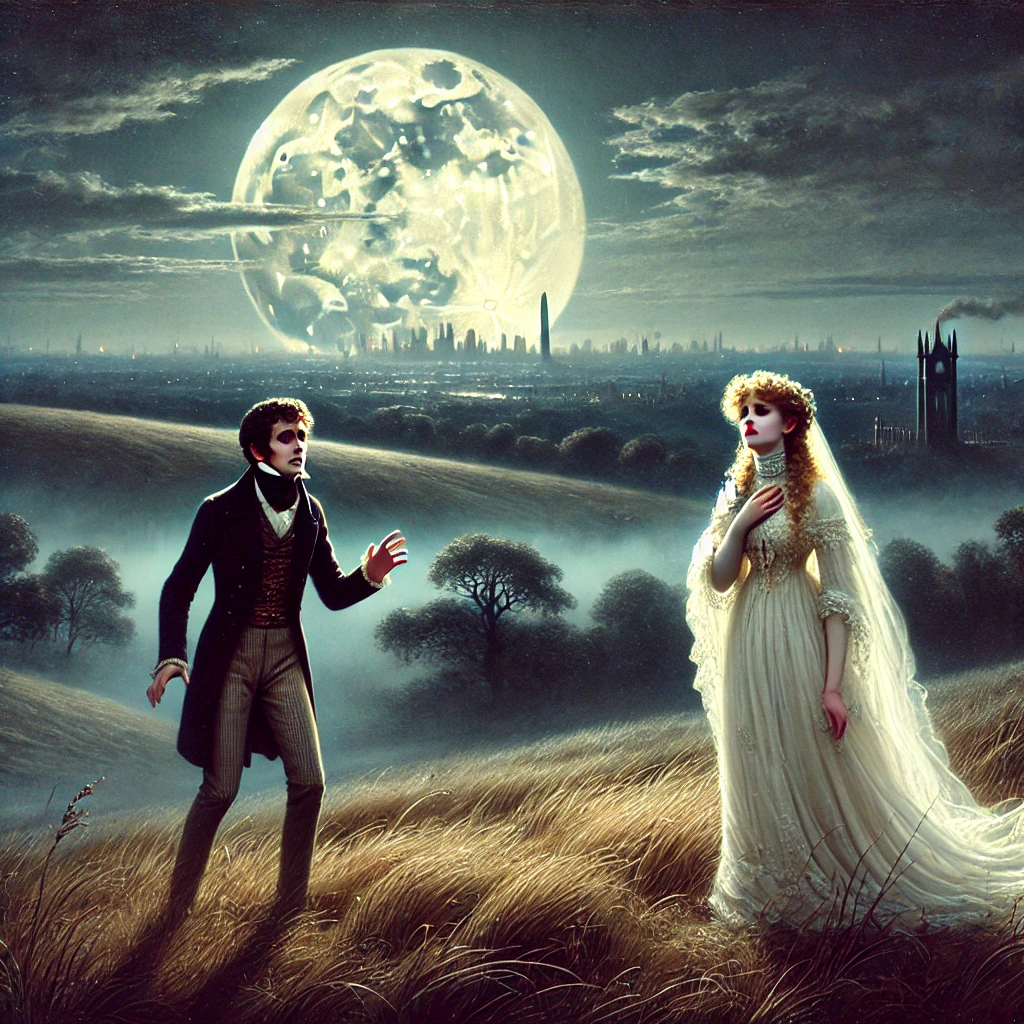The Machine Stops is a dystopian science fiction short story by E.M. Forster, published in 1909. Set in a world where humans live isolated in underground rooms, the story presents a society entirely dependent on an all-encompassing technological system, “the Machine,” which provides for all physical and intellectual needs. Forster’s work is a critique of over-reliance on technology, foreshadowing themes relevant to modern discussions on technology and human interaction.
Plot Summary
In a distant future, humankind lives scattered in isolated underground cells, each connected by the all-encompassing power of the Machine. This system provides for every conceivable need, from air and light to food and entertainment, allowing people to lead solitary lives filled with intellectual pursuits and virtual connections. The Machine’s authority has become so absolute that citizens regard it with reverence, trusting its Book for guidance on how to operate every aspect of life and solve any difficulty. Under the Machine’s governance, physical travel is rare, and direct human contact has fallen into disdain. People prefer the safety of their cells and rely on virtual gatherings to communicate and explore ideas. In this world of sterile routines, nature is seen as chaotic and primitive, a memory faded into myth.
Vashti, a woman who has embraced the Machine’s order and comforts, prepares to give a lecture on ancient music from her cell. While her life consists of scholarly pursuits, music, and brief discussions with virtual acquaintances, she finds satisfaction in this regulated existence. One day, her son Kuno, who resides in a cell on the opposite side of the Earth, contacts her with an unusual request: he wants her to visit him in person. Though she initially resists, citing her distaste for the “horrible brown earth,” she reluctantly boards an airship and makes the journey. Upon arrival, Kuno reveals a shocking wish—he longs to see the surface of the Earth with his own eyes, without the barrier of the Machine. This desire disturbs Vashti, who views the outside world as dangerous, barren, and void of ideas.
Yet Kuno’s yearning cannot be quenched. Despite the strict limitations imposed by the Machine, he embarks on a daring journey to the surface through an old ventilation shaft. He recounts his experience to his mother, describing the awe of the open air and the stars above, which stir something deep within him. He realizes that life exists beyond the Machine’s control, a revelation that fills him with a sense of humanity his world has long lost. But his adventure brings swift punishment. For violating the Machine’s protocols, Kuno is threatened with “Homelessness,” a severe penalty that condemns one to live on the uninhabitable surface of the Earth, a fate that means certain death.
Despite her son’s warnings and his criticism of the Machine’s growing control over human lives, Vashti remains committed to her orderly existence. Over time, however, faint signs of trouble begin to appear. The Machine occasionally malfunctions: sometimes the lights flicker or the music distorts, and the carefully maintained artificial fruit loses its flavor. The authorities assure the citizens that repairs are underway, but the minor inconveniences become regular annoyances. Though people like Vashti adapt to the Machine’s quirks, a creeping sense of discomfort settles into the heart of this ordered world.
As the years pass, Vashti continues her life of lectures and scholarly exchanges, dismissing Kuno’s rebellious spirit as impractical and even dangerous. She believes firmly in the Machine’s wisdom, confident that any error or fault will be quickly resolved. But Kuno’s defiance lingers in her mind, casting a shadow over her contentment. In one of their rare communications, Kuno tells her that he believes the Machine is deteriorating. Vashti laughs at what she sees as absurdity, clinging to the belief that the Machine is eternal and infallible.
Then, the problems with the Machine worsen. A loud, irregular hum fills the air, drowning out even the daily lectures. The air becomes stale, and the artificial light fades. Despite complaints, the Machine’s self-repair system—the famed Mending Apparatus—fails to respond, leaving the citizens in growing discomfort. Many dismiss the issues as temporary annoyances, refusing to acknowledge that their world is faltering. But soon, even the simplest comforts vanish. The air is thick, the food tainted, and the water supplies foul. Panic grows, but the people’s dependency on the Machine leaves them helpless, incapable of surviving without its care.
Amidst the unfolding collapse, Kuno’s words return to Vashti: the Machine is stopping. The terror of his prediction grips her as the collapse accelerates. Across the vast underground network, citizens cling to their copies of the Book, pressing buttons that no longer respond. With mounting desperation, they watch the flickering lights go out, leaving them in near-darkness, the constant hum of the Machine fading to silence. In her cell, Vashti realizes she can no longer summon food, water, or air. The reality that the Machine—the only world she has ever known—is no longer functional overwhelms her with fear.
Desperate for escape, Vashti opens the door of her cell and is confronted by a sight more horrific than she could have imagined. The narrow tunnels are filled with people for the first time in generations, pressing against each other in panic, stumbling blindly in search of a way out. Strangers jostle and cry out, each person as bewildered and helpless as the next. Vashti tries to understand how her structured world has dissolved into chaos, but she cannot comprehend existence without the Machine’s comforting hum and glow.
In the final throes of the Machine’s demise, Vashti encounters Kuno among the throngs of the Homeless. He speaks to her one last time, and together they bear witness to the inevitable end. In the darkness, he expresses his sorrow for what humanity has lost, lamenting how the Machine had severed people from one another and from the world itself. The oppressive system that had once served humanity had taken their freedom, their creativity, and their physical strength. Now, in the Machine’s failure, the depth of its control becomes horrifyingly clear.
As the Machine completely stops, the underground complex collapses, and those who once worshipped the Machine find themselves consumed by the very thing they had trusted to sustain them. In their final moments, Kuno and Vashti understand the price of dependency, realizing that human connection and nature had been sacrificed in favor of artificial convenience. Their brief reunion is engulfed by darkness as the Machine’s final hum fades, leaving humanity’s last vestiges to vanish into the silence from which they had once sought escape.
Main Characters
Vashti: A dedicated follower of the Machine, Vashti is a lecturer who lives in isolation, satisfied with a life regulated entirely by the Machine. Her dependency on the system blinds her to the deeper needs of human connection and curiosity, representing the average citizen in this highly controlled society.
Kuno: Vashti’s son, Kuno is restless and questions the authority and limitations of the Machine. His desire to experience the surface of the Earth and life outside of the Machine’s reach brings him into direct conflict with society’s norms, positioning him as the voice of dissent and the story’s central figure of resistance.
Theme
Dependence on Technology: The story explores a society where humans have surrendered all autonomy to a machine, which controls their daily lives and isolates them from nature and genuine human contact. This theme critiques the potential loss of individuality and autonomy in a society increasingly dominated by technological conveniences.
Isolation and Human Connection: The inhabitants live in physical and emotional isolation, interacting solely through the Machine’s virtual channels. Forster examines the consequences of a life devoid of real human touch and natural experience, illustrating a stark contrast between technological comfort and human yearning.
The Fallibility of Systems: Forster questions the reliability of even the most advanced systems. As the Machine begins to fail, society’s helplessness and inability to adapt underscore the dangers of blind faith in infallible systems and highlight humanity’s fragility when divorced from nature and personal agency.
Rebellion and Curiosity: Kuno’s urge to explore the forbidden surface symbolizes innate human curiosity and the spirit of rebellion against stifling conformity. His character explores the conflict between curiosity and complacency within a controlled society.
Writing Style and Tone
Forster’s writing is deliberate and evocative, using precise, somewhat sterile descriptions to mirror the impersonal, automated world of the Machine. His style emphasizes the alienation and sterility of the characters’ lives, a choice that vividly contrasts the rare descriptions of nature with the mechanical monotony of life under the Machine. Through restrained prose, Forster builds a tension between the reader’s awareness of what is lost (genuine human experience) and the characters’ complacent ignorance.
The tone of The Machine Stops is cautionary, sometimes somber, as it highlights the dangers of substituting human connection and natural experiences with artificial constructs. Forster’s dystopian vision carries a sense of inevitability that mirrors his characters’ helpless dependency on technology. His tone conveys a sense of alarm and urgency, foreshadowing the collapse of the Machine, and by extension, society, as an ominous warning against the unchecked progression of technological dominance.
We hope this summary has sparked your interest and would appreciate you following Celsius 233 on social media:
There’s a treasure trove of other fascinating book summaries waiting for you. Check out our collection of stories that inspire, thrill, and provoke thought, just like this one by checking out the Book Shelf or the Library
Remember, while our summaries capture the essence, they can never replace the full experience of reading the book. If this summary intrigued you, consider diving into the complete story – buy the book and immerse yourself in the author’s original work.
If you want to request a book summary, click here.
When Saurabh is not working/watching football/reading books/traveling, you can reach him via Twitter/X, LinkedIn, or Threads
Restart reading!








